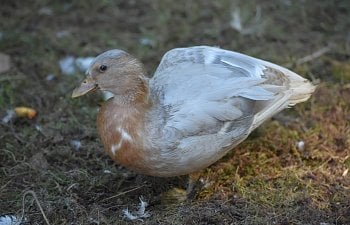Mallard Derived Duck Color Genetics Basics

Ducks have come a long way since they were first domesticated from mallards and now come in many beautiful colors. This article will explore how the genetics behind these colors work, and how a duck comes to look the way it does. Please note that this article only applies to duck breeds that were derived from the mallard; muscovy ducks, being a different species, have a whole other set of genetics behind their colors.
To start with, we'll cover some basic genetic principles. Alleles (one of two or more alternative forms of a gene that are found at the same place on a chromosome) can be dominant or recessive. A dominant allele, as it sounds, is dominant, and expresses even if there is only one copy of it. A recessive allele needs two copies to express.
So a duckling would only need to inherit one dominant allele from one of its parents for that trait to express, but would need to get two copies of a recessive allele, one from each parent, for a recessive trait to express.
Also, birds have different chromosomes than we do. A male bird has ZZ chromosomes, and a female has ZW chromosomes. Some traits are sex linked, meaning they are linked to the Z chromosome. Since females only have one Z chromosome, they only need to receive one allele for the trait to express, whether it is recessive or dominant. Males need to inherit two copies for the trait to express if it is a recessive trait. An example of this would be the chocolate color, which we will talk about later.
You can utilize these sex linked genes to make sex linked ducklings, where males and females hatch out different colors.
Let's start looking at some of the genetics behind the colors. We'll begin by taking a look at the individual genes. The + sign beside some of these alleles indicates that they are wild-type genes, the ones found in the original wild mallard. Alleles written capitalized are dominant, and those written lower case are recessive.
Here's an example of how these genes are written out to describe the color of a duck, using the basic mallard gray color:
M+M+ Li+Li+ e+e+ bl+bl+ C+C+ B+B+ r+r+ D+D+ Bu+Bu+
The above sequence is for a drake. A female's sequence would read like this:
M+M+ Li+Li+ e+e+ bl+bl+ C+C+ B+B+ r+r+ D+ - Bu+ -
The dashes indicate where she can only inherit one copy of a gene, due to her W chromosome.
The Mallard Alleles (M+, M^R, m^d)
M+
This is the wild-type mallard allele. Ducklings hatch with the camouflage pattern of black and yellow that you can see on breeds like the mallard, rouen, and gray Call ducks. They will have black backs, black lines over their eyes, four yellow dots on their backs, and yellow bellies. Adult females and juvenile males, or males in eclipse plumage, have pencilled brown plumage and eye stripes. Adult drakes in nuptial plumage have green heads, a white throat ring, and a claret breast.
Here is a gray call duckling, showing the normal mallard color patterns in her down:
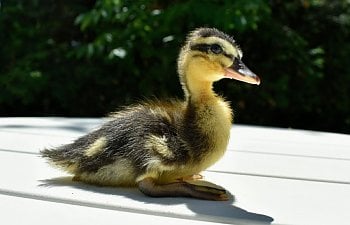
M^R
This allele is called restricted mallard. As it sounds, it restricts the mallard coloration. It's most noticeable in ducklings. The black color usually found all over the duckling is instead restricted to the tail and a black mohawk on the head. Silver appleyard ducklings are an example of this coloration. In adults, it is harder to see, and mostly manifests in the wing fronts and wing bows as white being present. This allele is very dominant, and will express over M+ as well as m^d. So if a duck is M^RM+, it will be restricted mallard.
m^d
This is the dusky mallard allele. It removes the typical eye stripes found in the basic mallard pattern. Ducklings have their pigment spread evenly over their bodies with none of the usual eye stripes or back spots showing. Adult females lack eyestripes, and adult males lack the throat ring and claret breast. This allele is recessive, and a duck must have two copies of it for it to express.
Here is a regular pastel female with the M+ mallard gene first, and second a dusky pastel female with m^d dusky mallard. Note her lack of eyestripes; these females are the exact same color aside from this gene.
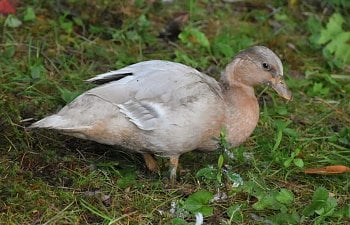
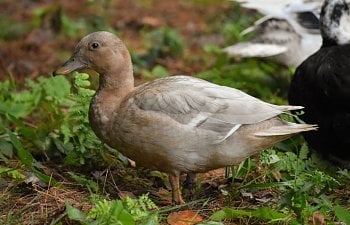
The Color Phase Alleles
These alleles act on the mallard genes to change the color, either by adding white or lightening them or both. Generally it is more noticeable on females.
Li+
This is your basic wild color phase, and is the darkest. Gray call ducks, rouens, and mallards are all this color.
li
This is light phase. It lightens the colors of the feathers from dark brown to light brown. This gene is present in some colors like silver appleyard. Rouen Clairs, a utility breed in France, are light phase mallard.
li^h
This is the harlequin gene. It creates my favorite color in ducks, snowy. This lightens the brown and increases the amount of white in the bird's plumage and creates a beautiful harlequin pattern. Ducklings are very noticeably this color at hatch - they are yellow with black stippling on the down. Adults also lack eyestripes. Breeds in this color include snowy Calls and silver phase welsh harlequins.
First is a snowy Call duckling, and second is a silver phase welsh harlequin duck.
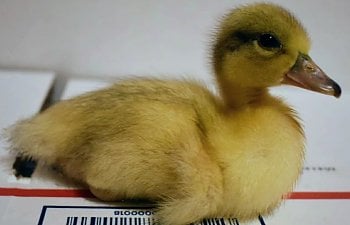
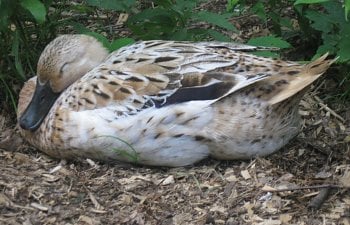
The Black Alleles (e+, E)
This gene determines whether a duck is black or not, and is pretty simple. There are only two alleles for this gene.
e+
This is the wild type allele that basically means 'not black'. It's recessive, so a duck must have two copies to not be black. All mallard type colors are based on this allele.
The blue fawn Call duck below must have a genotype of e+e+, or she would be blue instead of blue fawn.
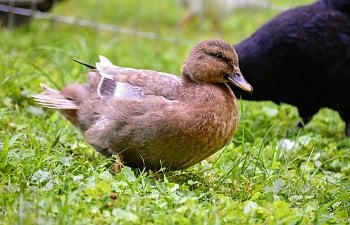
E
This allele is called Extended Black. If a duck has even one copy of this gene, its base color becomes black, not mallard. So a duck that would otherwise be regular mallard color, upon inheriting a copy of this gene, will instead be black.
This mismarked black magpie Call drake must have at least one copy of E, and possibly two:
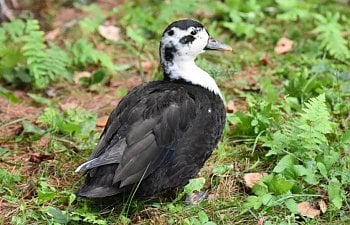
The Blue Alleles (bl+, BL
These alleles make up the blue dilution gene. This gene is primarily a diluter of eumelanin (black pigment). This gene breeds just like BBS (blue, black, splash) does in chickens. One copy of the blue dilution allele results in a blue bird. Two copies results in a silver bird. This gene can act on all colors.
bl+
This is the basic wild type allele. It is the absence of the blue dilution gene. A duck with two copies of this allele is just your basic not blue color.
This gray Call duck has two copies of the bl+ allele:
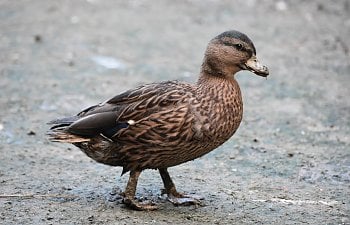
Bl
This is the blue dilution allele. A bird with one copy of this allele is blue. A bird with two copies is silver. Some silvers can be so light that they look almost white.
Frist is a blue fawn Call duck, who has one copy of the Bl allele. Second is a pastel Call duck, who has two copies of the Bl allele, making her even lighter.
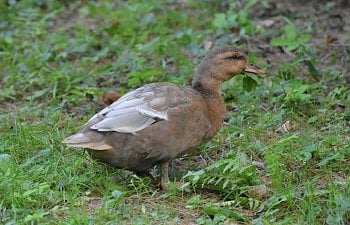

Blue and pastel might be hard to see on some mallard colors, such as snowy, but you can still tell. The wing speculum is the giveaway. When a duck has a copy of the Bl allele, their speculum becomes a gray color. Two copies and it's a light gray, almost silver, color.
First is the speculum of a regular snowy bird, in this case a welsh harlequin drake. Second is the speculum of a blue snowy.
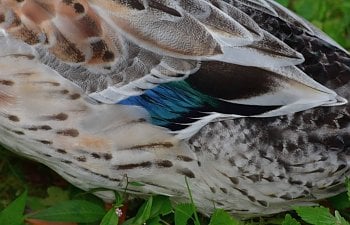
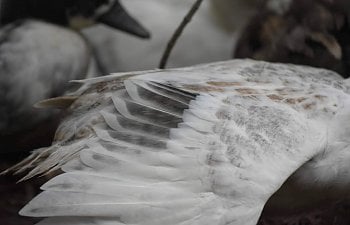
The White Alleles (C+, c)
These alleles control the white gene. The white gene actually inhibits color pigment, preventing it from forming or getting into the feather. As such, it doesn't matter what color a duck would otherwise be, if it has two recessive white alleles, it's white. Two whites bred together can only produce white offspring because of this.
C+
This is the wild type not-white allele. It's dominant, so a duck with one copy of this gene will not be white. They might carry white, or be homozygous for C+, but either way, they will not be white.
c
This is the recessive white allele. This allele is the one that turns ducks white. It's recessive, so a duck must have two copies of it to be white. White is epistatic to all other color genes, so any duck that carries two copies is white, no matter what.
This pekin duck below must be homozygous for white. She could be any color at all 'underneath'.
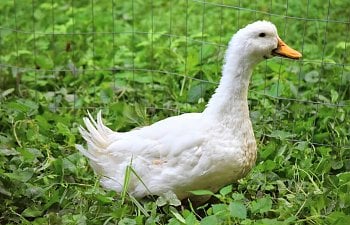
The Bibbing Alleles (B+, b)
These are the alleles that control recessive bibbing. There may be another dominant bibbing gene as well that is linked to extended black, or that type of bibbing may be an interaction effect, we are not sure. But this type of bibbing controlled by these alleles is recessive.
B+
This is the wild type dominant not-bibbed allele. Any duck having this allele will not have a recessive bib. They might still have a bib, though, since some bibbing is linked to extended black.
b
This is the allele for recessive bibbing. Any duck that has two copies of this allele will have a bib. Sometimes you see mallards with bibs, and that would be due to this allele. An example of such a mallard can be seen here.
The Runner Pattern Alleles (r+, R)
This gene is named after the pattern seen on fawn and white runners, thus the name Runner Pattern. These alleles cause white patterns in the feathers. Sometimes the resulting patterns are called pied, and sometimes they are called pencilled. Fawn and white runners of course get their color from this gene. Magpie is a combination of runner pattern and a bib.
r+
This is the basic wildtype allele. A duck with two copies of this allele has no runner pattern white patches.
R
This is the allele for white marking. It has variable expression, and seems to be influenced by unknown modifying genes. This same gene causes the white markings on fawn and white runners, pencilled Calls, Magpie ducks, etc. One copy of the allele will give the bird white markings.
This silver magpie Call duck has both a bib and two copies of the R allele:
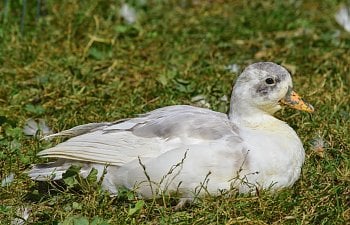
The Chocolate Dilution Alleles (D+, d)
This gene controls chocolate dilution, or whether a duck is chocolate in color or not. It dilutes the black pigment to a chocolate brown. This gene is kind of fun, because it's sex linked. As was talked about earlier, birds have different chromosomes than we do, with males being ZZ and females being ZW. Chocolate dilution is recessive and linked to the Z chromosome.
D+
This is the wildtype not chocolate allele. A duck that has one or two copies of this allele will not be chocolate.
d
This allele causes chocolate dilution. It's recessive and sex linked, so a male needs to get two copies of it to be chocolate. However, a female, only having one Z chromosome, needs only to inherit one copy for it to express and to be chocolate. It's possible to use this fact to create sex linked ducklings, with males and females hatching different colors at hatch.
Khaki campbell ducks gain their color from this allele, as do chocolate Calls, chocolate Anconas, etc.
This gene can also interact with the blue dilution gene to create other colors, such as the Lilac and Lavender colors that can be found in Calls.
This female Call duck is chocolate, and has one copy of the d allele:
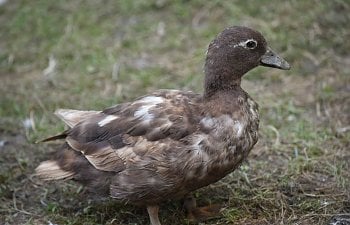
The Buff Dilution Alleles ( Bu+, bu)
This gene controls buff dilution, which lightens up a duck's feathers, and also their bill, legs, and feet. Just like chocolate, this gene is also sex linked and recessive.
Bu+
This allele is the wildtype allele that means a duck is not buff. It is dominant, so if a duck has one or two copies of this allele, it will not be buff.
bu
This is the allele that causes buff dilution. Since it is recessive and sex linked, a male will need to receive two copies for it to take effect, while a female needs only and in fact can have only one. This gene will lighten a duck's color all over.
As you might expect, buff orpington ducks like the ones below get their buff color from this gene.
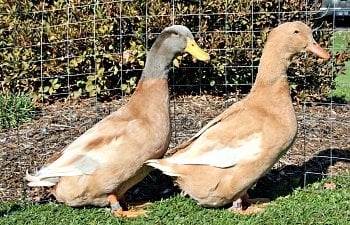
Putting It All Together
Now that we have covered all the different color genes, it can all be put together. For instance, looking at this sequence, what color is this duck?
M+m^d Li+Li+ e+e+ Blbl+ C+c B+B+ r+r+ D+D+ Bu+Bu+
Looking at this, we can tell what color this duck is, and even its gender. Because it can inherit two copies of chocolate (D+) and buff (Bu+), we know it's a drake. We can also see that it's regular mallard (M+), but that it's carrying a copy of dusky (m^d). It has one copy of the blue dilution gene (Bl), so we know that it's blue fawn, because it doesn't have an extended black (E) allele. We also know it's carrying recessive white (c).
What about this one?
M+M+ Li+Li+ Ee+ Blbl+ C+C+ B+B+ r+r+ D+- Bu+-
Did you guess blue bibbed? If so, you were right! She has an extended black (E) allele, turning her base color black, and one Bl allele, diluting her to blue. She has a bib because it's linked to the E allele.
Here she is:
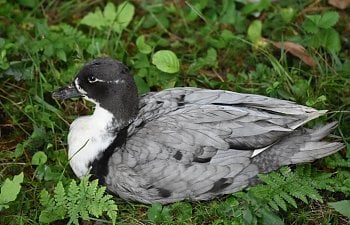
You can also use this information to plan breedings. Say you have this duck and one blue fawn drake. You really want pastel ducklings, but you can't buy any more ducks. The drake's genotype is as follows:
M+M+ Li+Li+ e+e+ Blbl+ C+C+ B+B+ r+r+ D+D+ Bu+Bu+
Can you pair this female up to a blue fawn male and get pastel ducklings?
Yes, you can. She carries an e+ allele, so she can produce mallard base ducklings. She has one Bl allele, and the drake does too, so some of their offspring will inherit one copy from both of them, making them silver. Silver on a mallard base is pastel.
Looking at the information we have, we can tell that together these ducks can produce black bibbed, blue bibbed, silver bibbed, grey, blue fawn, and pastel offspring.
We can also work backwards to figure out what the parent ducks' genotypes are by looking at their offspring.
Say you have this drake on the left, and you bred him to this duck on the right:

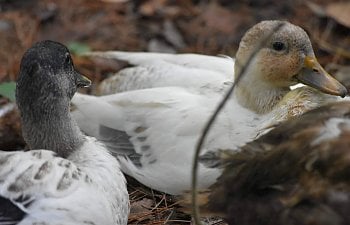
The male is a grey, and he was hatched from a pen made up of snowies, duskies, and greys. The female is a silver snowy, and in the past we know that dusky may have been bred into her line. Neither line has ever contained white ducks. We hatch their offspring, and the resulting ducklings are blue fawn, blue fawn dusky, blue snowy, and dusky blue snowy.
This tells us a lot. Now we know that our grey drake is carrying both the harlequin gene and the dusky gene. So we now know his genotype is this:
M+m^d Li+li^h e+e+ bl+bl+ C+C+ B+B+ r+r+ D+D+ Bu+Bu+
We also know the snowy must be carrying dusky too, or there would have been no dusky offspring. She must be silver, since there were only blue ducklings. So her genotype looks like this:
M+m^d Li+Li+ e+e+ BlBl C+C+ B+B+ r+r+ D+- Bu+-
In Closing
Knowing how the color genetics work and how to put it all together will help you know what to expect when breeding ducks, and how to combine colors when breeding to get new colors, or make sure that you get the colors you want.
If you want to have fun playing around with the color genetics, you can check out this duck color genetics calculator.
You can also browse the Ducks forum here on BYC for lots of threads showing off all the gorgeous colors ducks can be, and some threads that discuss color genetics too.

